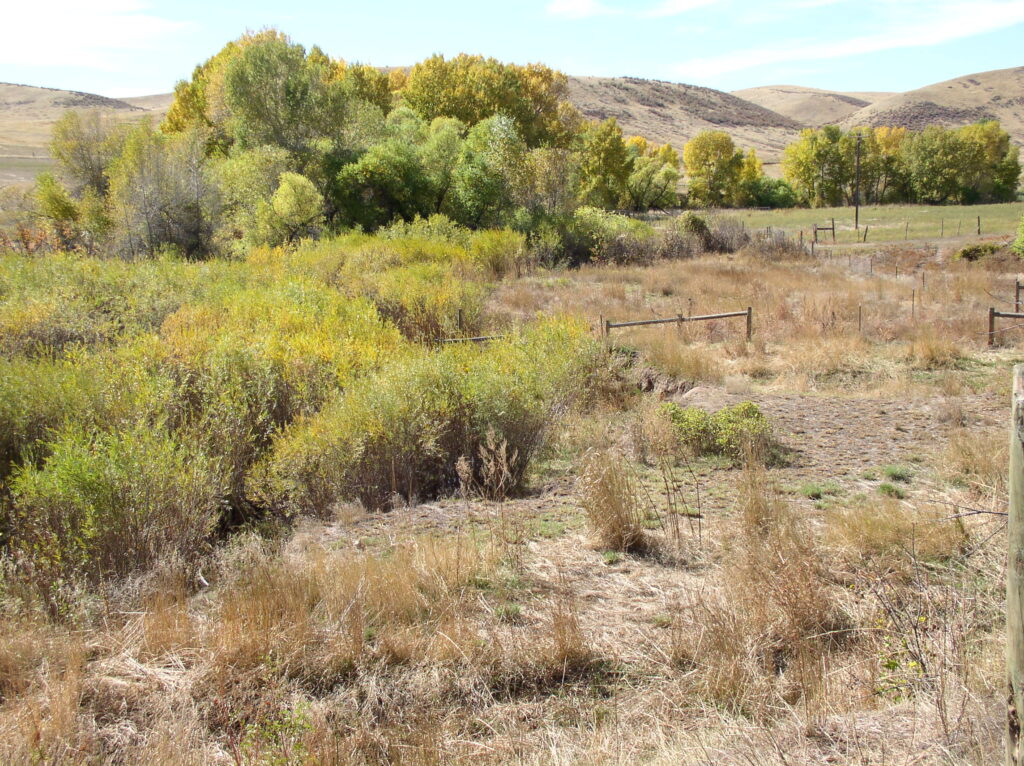By George and Sarah Seidel, John Fusaro and Heather Knight

The Seidel family have a ranching operation in Livermore. The main part of the ranch lies along Rabbit Creek which affords habitat for diverse terrestrial and riparian species, including cottonwoods, willows, birch and alder, turkey, beaver, black bear, mountain lions, numerous songbirds, and Preble’s Meadow Jumping mice. Like most ranchers and conservationists, the Seidel’s value the land and water and wildlife on the lands they steward.
The ranch operation has just over 300 mother cows plus young stock and bulls. They sell weaned calves and about 15 breeding bulls each year. They also have almost 300 acres of irrigated hay; and sell the best hay for horses and feed the rest. They have three employees who live in the area.
When asked to describe their approach to the land George, Sarah and Andrew reply thoughtfully. “Our main goals include having a profitable and sustainable ranching enterprise; humane treatment of animals; a pleasant surrounding for ourselves, employees, guests, and neighbors; and maintaining and improving the environment. We continually are doing conservation projects such as fencing riparian areas, planting trees, and developing water sources for cattle away from riparian areas”.
For many years the Seidel family dreamt about improving and restoring the riparian area on the ranch. A lack of resources had been the obstacle. This riparian area on the ranch had been in George’s words, “heavily grazed for the past century. It is adjacent to a county road and was used by various groups to demonstrate a degraded riparian area, not a very flattering situation”.
A relationship between The Nature Conservancy and the Seidel family and other agency partners had been developing in the community since the early 199’s. In 1999 the Seidel family placed the first conservation on part of their ranch and a second in 2005. Then, in 2000 The Nature Conservancy (TNC), the Natural resources Conservation Service (NRCS), the US Fish and Wildlife Service (USFWS), Colorado State University (CSU), Livermore Elementary School, volunteers and private funders came together to start a joint riparian restoration project on Rabbit Creek.

The first step was to decide to take action and bring together the partners. The Nature Conservancy helped to facilitate the first of many field visits. The team of experts, hydrologists, biologists, ecologists, range and livestock managers, agreed that many parts of the riparian plant and animal community and hydrology were still intact, and with the minimal investment restoration of the system could occur.
Adaptive approach was taken. Objectives for the project included 1) to restore the native plant community so that the banks of the stream were stabilized, habitat for animal species was restored, hydraulics of the system were returned, and 2) to restore flows in the stream bed to support native species and provide a more consistent and cleaner water supply for irrigation and livestock.
Each partner brought their skills to the project. Permanent pre-project hydrologic and riparian monitoring was established by CSU, consultants and TNC volunteers. Private funds and donations of time covered the cost of monitoring. John Fusaro and other staff of the NRCS provided technical assistance which consisted of fence layout, water gap and crossing design, and dormant willow cutting and planting guidance. The NRCS and USFWS shared the cost with the landowner for fencing, making water gaps so cows still could drink, and planting some willows. The Livermore School adopted the site as part of their ongoing place- based education program and with the help of TNC and the NRCS helped students from grades 1 through 6 plant willows taken as cuttings from an adjacent area and seedlings purchased from the Colorado State Forest Service. TNC hosted stewardship days to manage weeds and continue monitoring.
The fence, water gaps and willow plantings enabled the riparian zone to re-establish, reduced sedimentation in the stream, improved the fishery, and improved the habitat for wildlife while still allowing for the watering of livestock and their ability to cross the creek into other pastures. Gates in the fence enable the area to be flash grazed when needed to help control any weed growth. According to John, and the photos show this too, “this project is a good illustration of how grazing, wildlife, healthy streams and water quality can all co-exist”.

We know that any management, whether it is grazing or the use of fire, if done right is positive and if done poorly can negatively impact land and water. The native plant and animal communities in the Laramie Foothills evolved with disturbances of grazing, fire, flood, wind, insects, disease, and small mammal burrowing. For land managers who care about conservation and sustainable land use, the trick is finding the balance when using such tools to steward land that results in the promotion of both.
Thanks to the efforts of this partnership and especially to the Seidel’s we can demonstrate to others in the community riparian management done right. George said it simply, “it was surprising to us how rapidly this riparian area recovered”.
When asked about her reflections on the project, 18 years post implementation, Sarah Seidel co-owner of Rabbit Creek Ranch, said “The project has done a great deal toward conserving the riparian area, benefiting Preble’s mouse and other wildlife. It has not limited our ranching operation. The volunteer time and technical assistance to implement the project was appreciated and funding alleviated any major budget concerns.”
North Fork Poudre SCT Spring 2023 Newsletter Project Spotlight

